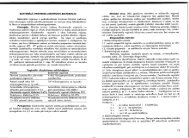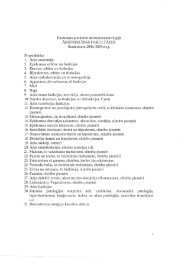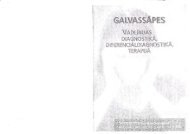PHYSICS
n - susliks.lv
n - susliks.lv
- No tags were found...
Create successful ePaper yourself
Turn your PDF publications into a flip-book with our unique Google optimized e-Paper software.
the potential difference across the horizontal plates which varies<br />
in time with a sawtooth waveform. The field across the vertical<br />
plates is controlled by the potential difference across the source<br />
under investigation, hence a two dimensional image is formed on<br />
the screen.<br />
15.3. CURRENT ELECTRICITY<br />
15.3.1. Electric Current<br />
The term electric current is used to describe the rate of flow of<br />
charge through some region of space. If L1q is the amount of<br />
charge that passes through the area (S) in a time interval L1t, the<br />
average current « I » is equal to the ratio of the charge to the<br />
time interval:<br />
< I > = ~q (15.16)<br />
~t<br />
If the rate at which the charge flows varies in time, the<br />
current also varies in time and we define the instantaneous current<br />
(I) as the differential limit of the expression above:<br />
1= dq<br />
dt<br />
The unit of current is the ampere (1 A = 1 Cis).<br />
(15.17)<br />
The current density (J) in the conductor is defined as the<br />
current per unit area:<br />
. I<br />
J = S (15.18)<br />
where I is a current, and S is the cross-sectional area of the<br />
conductor.<br />
This expression is valid only if the current density is uniform<br />
and the surface is perpendicular to the direction of the current. In<br />
general, the current density is a vector quantity. That is:<br />
J = nq < V > (15.19)<br />
where n represents the number of mobile charge carriers per unit<br />
volume which move with an average speed « V».<br />
The unit of current density is A/m 2 •<br />
118<br />
15.3.2. Current Circuits<br />
A closed circuit consists of a source of energy (e.g., a battery),<br />
called an electromotive force (E. M. F.) , and a resistor (fig. 15.4).<br />
Assuming that the connecting<br />
wires have no resistance, the<br />
source of E.M.F., E, has its<br />
own internal resistance (r). The<br />
external resistance (R), is often<br />
called the load resistance. The<br />
I<br />
voltage (U) is the difference in<br />
R electric charge between two<br />
points in a circuit.<br />
The unit of E.M.F. and<br />
voltage is the volt; resistance<br />
Fig. 15.4. Diagram of simple has units of volt per ampere<br />
electric circuit (iQ = IVIA).<br />
15.3.3. Ohm's Law<br />
Ohm's Law for Part of a Circuit: The electric current (I) flowing<br />
through a given resistance (R) is equal to the applied voltage (U)<br />
divided by the resistance, or:<br />
1= U (15.20)<br />
R<br />
Ohm's Law for a Closed Circuit: The amount of current flowing in<br />
a circuit made up of pure resistance is directly proportional to the<br />
electromotive forces impressed on the circuit and inversely<br />
proportional to the total resistance of the circuit:<br />
1= E/(R + r) (15.21)<br />
15.3.4. Kirchhoff's Rules<br />
Complex circuits (fig. 15.5) involving more then one loop are<br />
conveniently analyzed using Kirchhoff's rules:<br />
1. The sum of currents entering any junction must equal the sum<br />
of the currents leaving that junction:<br />
119






